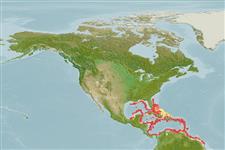>
Scombriformes (Mackerels) >
Gempylidae (Snake mackerels)
Etymology: Neoepinnula: Greek, neos = new + Latin ex = outside + Latin, diminutive of pinna = spiny (Ref. 45335).
Environment: milieu / climate zone / depth range / distribution range
Ökologie
seewasser benthopelagisch; tiefenbereich 184 - 457 m (Ref. 6181). Deep-water; 31°N - 3°N, 94°W - 49°W (Ref. 6181)
Western Atlantic: known only from the Gulf of Mexico, Yucatán Channel, Caribbean Sea off Venezuela, off Suriname, and off southern Brazil (Ref. 47377).
Size / Gewicht / Alter
Maturity: Lm ? range ? - ? cm
Max length : 22.0 cm SL Männchen/unbestimmt; (Ref. 6181)
Rückenflossenstacheln (insgesamt): 27; Rückenflossenweichstrahlen (insgesamt): 17-20; Afterflossenstacheln 3; Afterflossenweichstrahlen: 17 - 20. There are two lateral lines on the sides, both originating above the upper angle of the gill opening. Sometimes the lower lateral line branches off from the second or third tubular scale of the upper lateral line. The sides are silvery, the back brown; the first dorsal fin is blackish, the second dorsal fin black anteriorly; the buccal cavity is pale, and the branchial cavity pale to dusky.
Life cycle and mating behavior
Geschlechtsreife | Fortpflanzung | Ablaichen | Eier | Fecundity | Larven
Nakamura, I. and N.V. Parin, 1993. FAO Species Catalogue. Vol. 15. Snake mackerels and cutlassfishes of the world (families Gempylidae and Trichiuridae). An annotated and illustrated catalogue of the snake mackerels, snoeks, escolars, gemfishes, sackfishes, domine, oilfish, cutlassfishes,. scabbardfishes, hairtails, and frostfishes known to date. FAO Fish. Synop. 125(15):136 p. (Ref. 6181)
IUCN Rote Liste Status (Ref. 130435)
Bedrohung für Menschen
Harmless
Nutzung durch Menschen
Mehr Information
NamenSynonymeMetabolismusRäuberÖkotoxikologieFortpflanzungGeschlechtsreifeAblaichenSpawning aggregationFecundityEierEientwicklung
ReferenzenAquakulturAquakultur ProfilZuchtlinienGenetikElectrophoresesVererbbarkeitKrankheitenVerarbeitungNutrientsMass conversion
PartnerBilderStamps, Coins Misc.LauteCiguateraGeschwindigkeitSchwimmstilKiemenoberflächeOtolithsGehirngrößeSehfähigkeit
Tools
Zusatzinformationen
Download XML
Internet Quellen
Estimates based on models
Preferred temperature (Ref.
123201): 9.9 - 19.6, mean 16 °C (based on 46 cells).
Phylogenetic diversity index (Ref.
82804): PD
50 = 0.7500 [Uniqueness, from 0.5 = low to 2.0 = high].
Bayesian length-weight: a=0.01023 (0.00426 - 0.02456), b=3.00 (2.80 - 3.20), in cm total length, based on LWR estimates for this (Sub)family-body shape (Ref.
93245).
Trophic level (Ref.
69278): 3.8 ±0.5 se; based on size and trophs of closest relatives
Widerstandsfähigkeit (Ref.
120179): hoch, Verdopplung der Population dauert weniger als 15 Monate. (Preliminary K or Fecundity.).
Fishing Vulnerability (Ref.
59153): Low vulnerability (17 of 100).
